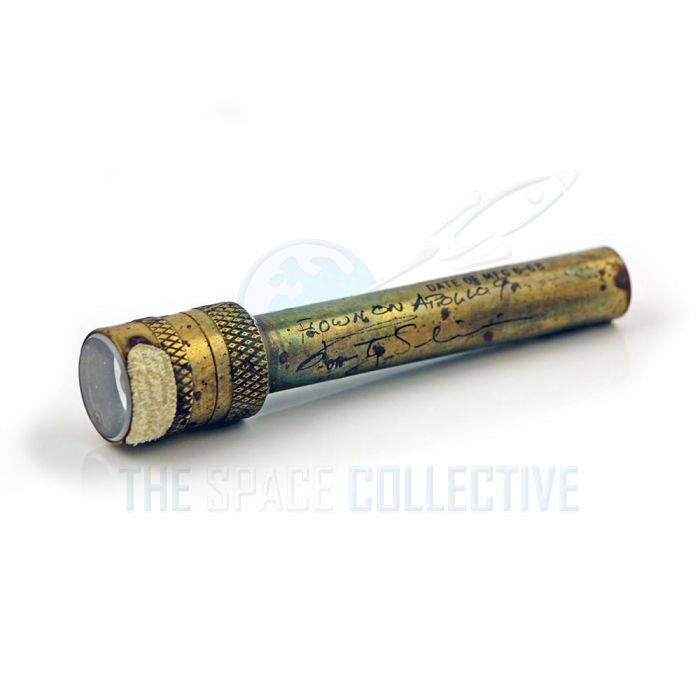

Apollo 9 CM & LM Flown Flashlight / Batteries & COA
Flashlight belonging to astronaut Rusty Schweickart and used aboard the Command and Lunar Modules during the Apollo 9 Mission. Signed twice in the barrel, comes with the original batteries and a letter of authenticity from Schweickart.
Out of stock
DESCRIPTION
Apollo 9 Flown Flashlight originally from the personal collection of Lunar Module Pilot Rusty Schweickart, Signed twice and includes a letter of authenticity from Rusty.
A heavy, brass-milled two-cell flashlight, 5.125" in length and with a maximum diameter of 1". The part number "ACR FA 5", serial number "1011", and date of manufacture "6/68" are all printed clearly on the barrel. "On" and "Off" are printed near the head which rotates to turn on and off. A piece of Velcro is attached at the top near the lens. Signed in black felt tip on the barrel: "Flown on Apollo 9/ Rusty Schweickart". Apollo astronauts were equipped with these small penlights for use throughout their mission. They proved to be quite handy for a variety of tasks. Lens is clear, very fine.
There were a total of 8 flashlights on the Apollo 9 mission, the crew had one each on their person at all times, stored in their PGA spacesuit pocket. There were also three spare flashlights in the Command Module and two spare in the Lunar Module, these were intended as backups should one ever fail, which they never did. Four of the Apollo 9 flown flashlights are currently stored at the National Air & Space Museum in Washington DC, one of which was the flashlight CMP Dave Scott used during the mission. This particular flashlight, serial numbered ''1011'' was used by LMP Rusty Schweickart throughout the mission, and when not in use it was stored in his PGA spacesuit pocket.
The batteries below were the very same batteries used in this flashlight during the Apollo 9 mission in 1969. They each read ''Sept. 68 / - RM - 12 CMC / 1.35v''. At some point after the flight, these batteries leaked. In order to better preserve the flashlight itself the batteries were removed, as was the excess battery acid residue left behind. Fortunately this took very little effort as the batteries practically fell out of their own accord.
Description
Apollo 9 Flown Flashlight originally from the personal collection of Lunar Module Pilot Rusty Schweickart, Signed twice and includes a letter of authenticity from Rusty.
A heavy, brass-milled two-cell flashlight, 5.125" in length and with a maximum diameter of 1". The part number "ACR FA 5", serial number "1011", and date of manufacture "6/68" are all printed clearly on the barrel. "On" and "Off" are printed near the head which rotates to turn on and off. A piece of Velcro is attached at the top near the lens. Signed in black felt tip on the barrel: "Flown on Apollo 9/ Rusty Schweickart". Apollo astronauts were equipped with these small penlights for use throughout their mission. They proved to be quite handy for a variety of tasks. Lens is clear, very fine.
There were a total of 8 flashlights on the Apollo 9 mission, the crew had one each on their person at all times, stored in their PGA spacesuit pocket. There were also three spare flashlights in the Command Module and two spare in the Lunar Module, these were intended as backups should one ever fail, which they never did. Four of the Apollo 9 flown flashlights are currently stored at the National Air & Space Museum in Washington DC, one of which was the flashlight CMP Dave Scott used during the mission. This particular flashlight, serial numbered ''1011'' was used by LMP Rusty Schweickart throughout the mission, and when not in use it was stored in his PGA spacesuit pocket.
The batteries below were the very same batteries used in this flashlight during the Apollo 9 mission in 1969. They each read ''Sept. 68 / - RM - 12 CMC / 1.35v''. At some point after the flight, these batteries leaked. In order to better preserve the flashlight itself the batteries were removed, as was the excess battery acid residue left behind. Fortunately this took very little effort as the batteries practically fell out of their own accord.
